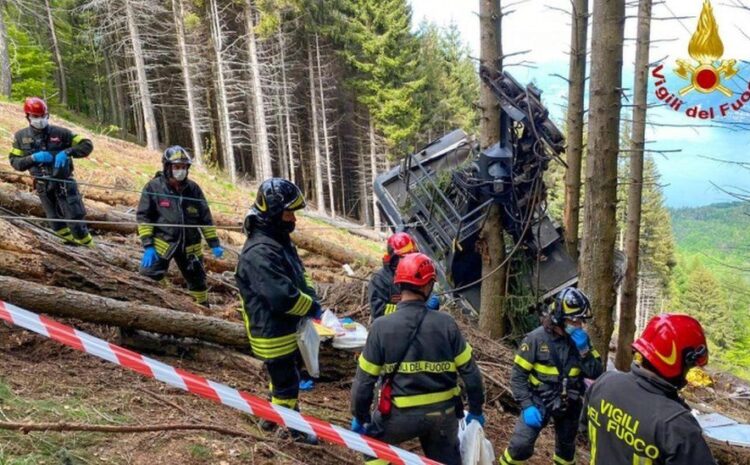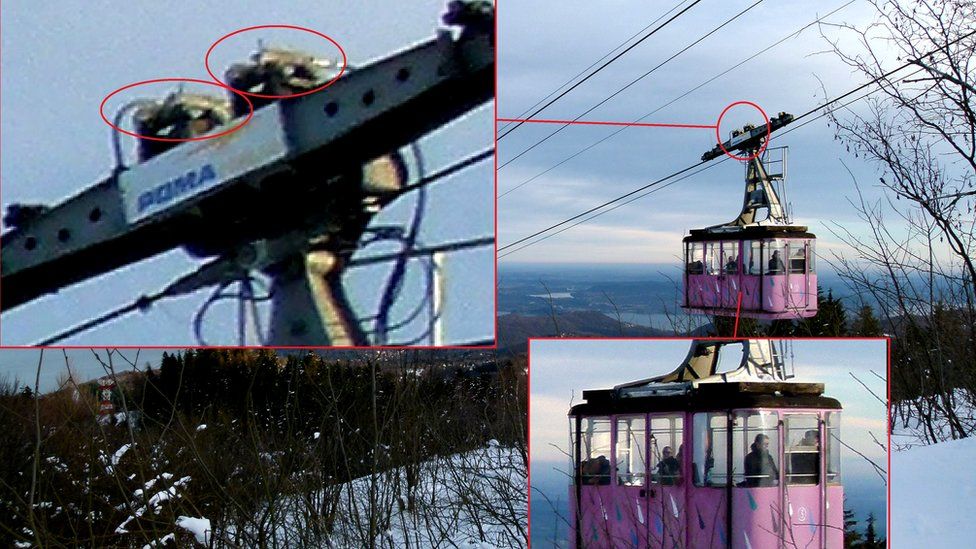
IMAGE COPYRIGHT EPA image caption Only one person survived the crash on 23 May
The cabin is seen nearing its final stop before suddenly rearing up, then speeding back down the mountain and crashing to the ground.
The prosecutor in the case spoke of “the absolute inappropriateness” of publishing the footage.
The head of Rai TV said he was “deeply shocked” by the decision to show it.
Five families were on board the car when it crashed, including two children who were among the dead.
Five-year-old Eitan Biran was the sole survivor when the main cable holding the car snapped on 23 May. He lost his parents and two-year-old brother, originally from Israel, and his great grandparents.
Suffering ‘cannot be exacerbated’
The CCTV footage was first obtained and shown on a news programme on Italian channel Rai 3, with the cabin blurred. It has since been republished in full or in part by several other Italian media, with some only obscuring the victims’ faces.
A second clip shows a worker running for help as the accident unfolds.
Prosecutor Olimpia Bossi said in a press release that although the suspects in the case were aware of the videos’ existence, relatives had not been informed and the broadcast of the footage was prohibited.
The suffering of the victims’ families, she said, “cannot and must not be further exacerbated by actions like this”.
The Italian Data Protection Authority has urged media organisations and social media users not to share the clips out of respect to the victims and their relatives, “so that pain does not become a tool for an extra like”.
Local Mayor Marcella Severino said she too was appalled by the decision to show the video: “I don’t think it was appropriate towards the victims and their families.”
The head of the public broadcaster, Marcello Foa, said he had “always respected the editorial choices of the directors and I have always refrained from commenting on them publicly, but as president of Rai in this case I cannot remain silent”.
“It is a duty for the public service, in circumstances like this, to carefully evaluate all the implications, starting with the ethical ones and respect for the victims and their families,” he added.
Politicians joined the condemnation.
Former education minister Valeria Fedeli said in a joint statement with fellow Democratic Party politician Andrea Romano that the channel needed to explain its actions.
The decision showed “total disrespect for the victims and their family members”, they argued, adding that the violation of the publication ban was “all the more serious because it was carried out by public service providers”.
However, La Stampa newspaper defended its decision to republish the footage, arguing that it was “stronger than 1,000 words and clarifies how the intervention of the brakes could have prevented the disaster”.
Three suspects from the company that operated the cable car are currently under investigation over the incident. A technician has admitted installing a fork-shaped bracket to deactivate the emergency brake, which had reportedly been malfunctioning, earlier this year.
However, a cable car expert has alleged that earlier videos he took suggest the emergency brake was already disabled in 2014.
 IMAGE COPYRIGHT MICHAEL MEIER
IMAGE COPYRIGHT MICHAEL MEIER